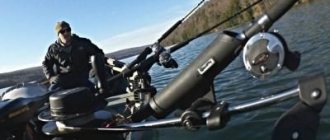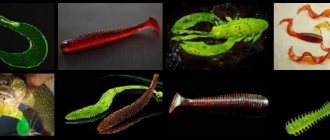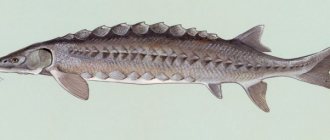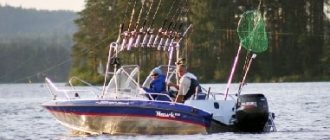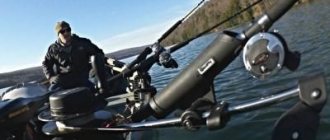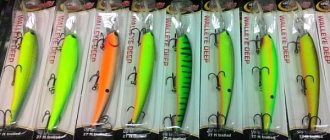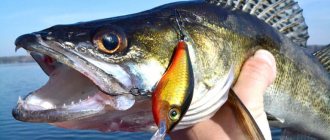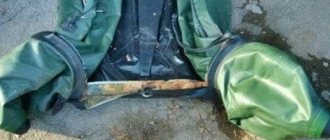Trolling is the process of moving bait using a motorized boat. Trolling fishing is quite diverse in terms of the equipment and accessories used. In this article we will consider only the main ones, the most used and in demand when trolling in freshwater bodies. Naturally, we believe that you have, at a minimum, a boat with a motor and a suitable spinning rod with the necessary bait. But whether or not to purchase the following devices is up to you.
BOAT RODS HOLDER
Rod holders on swimming craft are used both stationary and removable. Each method of attaching holders has both pros and cons, they are quite obvious, either mobility or solidity. The right choice greatly contributes to convenience, comfort and success when trolling. Thus, a spinning rod holder is a must-have accessory when trolling. And of course, every fisherman selects holders for his gear, for his boat, for his fishing technique, for a specific body of water. For some, it is enough to hold one rod in their hands, others use various additional equipment and a large number of rods, and of course it is difficult to do without rigidly fixed holders. There are many modifications of holders - with fastening to the side, transom, bench or other parts of the boat, with or without the ability to adjust the angle of inclination, metal, plastic, tubular, with fastening of the spinning rod at two points, etc. If you are just starting to master this type of fishing, and have not yet decided which accessories will be most in demand, and you have a PVC boat that has a liktros (it holds the seats, i.e. cans), then purchase a regular removable rod holder on a liktros, which can move along its entire length. This holder is simple, inexpensive and quite convenient when trolling with 1-2 rods. For example, you hold one rod in your hands, and the second is installed in this holder. It fulfills its functions, namely: after a bite, the rod should not fall overboard, and the time to pull the rod out should be minimal.
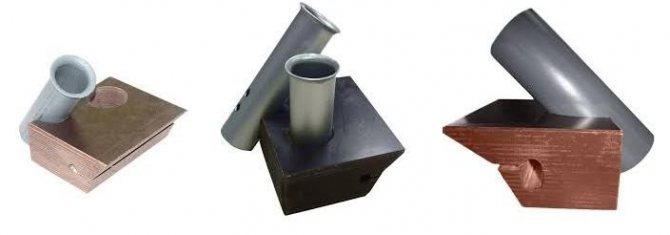
Boat equipment for trolling
So, you have seriously and professionally decided to take up trolling fishing, you have chosen a good boat for your conditions and selected an engine for it. But everything is just beginning. If for ordinary fishing (spinning, float, donkey, etc.) this would be quite enough, then for effective and comfortable trolling the boat still needs to be properly equipped with the necessary equipment, devices, devices and devices.
A short but succinct overview of the elements of trolling equipment continues.
The first thing that is especially worth paying attention to, without which trolling can be called a primitive path, is the presence of an echo sounder-chartplotter-navigator on board.
An echo sounder allows the fisherman to control the depth in the fishing area, identify underwater obstacles, edges, holes, and schools of fish. Which, with skillful analysis, increases the results of an experienced troller significantly.
A chartplotter together with a navigator allows the fisherman to create a navigation map of the area with promising fishing spots, plot routes, and mark underwater obstacles and depth differences on the maps. In general, enter all the summarizing information about a specific body of water into the device’s memory. More expensive devices allow you to take a three-dimensional image of the underwater space for a more complete understanding of what is happening under the boat.
At the moment, many manufacturers produce devices that combine the capabilities of all three devices, which eliminates the need for the fisherman to have a submarine cockpit with many sensors, screens and toggle switches in front of him. The cost is quite high, from 400 to 4000 USD and above. But trolling without an echo sounder is like driving a car with your eyes closed. The issue of having a device for echolocation on unfamiliar bodies of water and on bodies of water with a large water area is especially acute.
Hands-free is a necessary aspect of any trolling fishing, especially if the fisherman is alone in his quest to troll. This means that we need holders for spinning rods, which are installed on the stern of the boat. Holders vary in design, materials of manufacture, methods of fastening... Choose those that are more reliable and simpler. For example, steel ones made of duralumin are good.
A trolling glider is used to increase the fishable water area in one pass of the craft. Simply put, to distribute bait from, say, three spinning rods on opposite sides of the boat. Depending on the need, there are large and small, left and right, respectively, and the price ranges from 10 USD for a simple boat to 100 USD for a high-tech and complex glider.
If you have to fish at great depths, various deepeners are indispensable, which hold the bait at the depth set by the angler. This is also true if the fish is not at the bottom, but in a certain layer of water, which happens quite often. An additional factor and motivation for using deepeners may be the desire to cast catchable bait at great depths, which is not intended for this purpose. Depending on the design, such devices are divided into bladed ones, which work on the principle of wobblers - divers (Dipsy diver) and weight ones ( Sinker ), which work on the principle of a lead weight.
A more advanced deepening system is a downrigger. Relatively speaking, a load on a winch that gives maximum freedom when choosing the horizon for fishing. Downriggers offer the troller the greatest depths and can control the baits of several gears at the same time. The disadvantages include the bulkiness and rather high cost of the device. Depending on additional bells and whistles (electronic winch meter counter, additional depth control, rod mounts, etc.) the cost can reach hundreds of dollars. But, as you know, you have to pay for everything in this life.
Downrigger in action
A chipper, a release, a “cat” are those devices that, by spending money on them, you will only save your budget. It is clear that with this type of fishing, such as trolling, the number of hooks increases significantly. No matter how you look at the echo sounder screen, no matter how well you know the body of water, annoying losses of expensive baits cannot be avoided, but their consumption can be reduced. Depending on the type of hook, you need to use one or another device to rescue the bait. If the hook is dull and unyielding, then the flail is in the cramp or tree. We use a chipper and a release. If the hook is on something springy, the cat will help out. Often a cat helps out if the bait flies into old nets, crayfish traps, or nets.
To cope with a predator in a boat, you need to have a landing net, a hook and (or) the now fashionable Lip Grip fish holders. The latter injure the fish less than a hook and are often more convenient than a landing net. Everything is clear here. You can’t take a worthy opponent into a boat with your bare hands.
Excess or necessity? Dodgers and flashers were originally used for salmon fishing. But then they firmly entered the arsenal of many trolling fishermen. These devices give the baits a peculiar game and additionally attract fish from a greater distance, thanks to their shiny surface, vibrations and vibrations. Likewise, both the dodger and the flasher set the bait a certain trajectory of movement, which is an alternative to the native game and often gives good results. Now the market is oversaturated with all kinds of devices of different shapes and sizes. There are for sea and fresh water, for certain types of fish, and so on. The choice is yours.
Like any process that appeals to a large number of people, trolling is increasingly acquiring a large number of all kinds of gadgets that are designed to ensure the success and comfort of the fisherman. This is not a complete list of equipment used in trolling fishing. The list goes on and on: formwork, railings, traps, targs... Let's just say this is the required minimum.
And it’s already costing a pretty penny. Yes, trolling is an expensive pleasure, an elite form of fishing with all that it implies. And we haven’t bought trolling gear yet, which are also not cheap). But more on that in the next review. It's only the beginning.
SINKER
If trolling is done at shallow depths - up to 4 meters, then it is enough to choose a suitable wobbler or use a small load. But if it’s deeper, up to 6-10 meters, and your wobblers no longer go down to this depth, then there is the next category of deepeners, which are called sinkers. A sinker is a weight in the form of a plate, which allows you to deepen not only a shallow-water wobbler, but also a spinner (“spinner”, “shaker”) to the required depth. Attached between the rod and bait. There are various modifications of sinkers (Diving Sinker, Slide Diver, Bank Sinker, Inline Sinker) - different weights, different fastenings, adjustments, shapes and colors. The packaging usually indicates the required thickness of the fishing line, the weight of the bait, the distance from the boat, speed and other, it should be noted, very conditional characteristics.
The most interesting is the Diving Sinker - a diving sinker or, as they are also called, an adjustable diving weight. It is a lead weight that has a blade like a wobbler, which performs the same functions - it deepens the sinker when the wiring speed increases. On one side there is a triangular bracket on which the ring moves, to which the main line is attached. At the other end is a ring to which a leash with bait is attached. Interesting are sinkers with an adjustment plate, which allows you not only to deepen, but also to deflect the bait. This is important when fishing with several spinning rods in one boat and allows you to do without another device for trolling - a “boat” (more on that later).

BOUNSER
A tackle with a bouncer is more like a tackle with a retractable leash. The weight used is a bouncer - a streamlined weight that can be either wire or on a tube. Both models are quite convenient in their use, but the bouncer on the handset is more versatile. The distance from the leash attachment point to the bouncer is 40-50 cm, the leash should be the same length. Both the bouncer, the wobbler, and the speed of the boat must be selected in such a way that the wobbler does not fall below the level of the fishing line to which it is attached. It is clear that this is necessary so that the wobbler does not touch the bottom of the reservoir to minimize snags. The bouncer also serves the same purpose. For example, in a strong current, the bouncer can go above the wobbler’s submersion level, this should not happen. Either we replace the bouncer with a heavier one, or install a lighter shallow-water wobbler, or install a “braid” instead of a leash, or reduce the speed of the boat. For example, at a depth of up to 3 m we set a bouncer at 30 g, at 5 m - at 50 g, but this is with a moderate current. During the wiring process, the bouncer goes along the bottom, bending around the relief, the wobbler goes with some excess above the bottom.

Trolling
Trolling (or trolling) is a method of fishing in which a motorboat or rowing boat tows several baits behind it at the same time. This increases the chances of a good catch. The online store Badger.Ru offers everyone who wants to purchase trolling gear! Our catalog has a large selection of gear of different configurations that will help you achieve high catches when trolling fishing.
Choosing Trolling Gear
The gear in the catalog is presented in the following categories:
- manual and electric downriggers;
- spinning rod holders;
- clips;
- carbines;
- mini gliders (ships);
- modern accessories for trolling fishing.
Gear is divided into two large categories.
- For fishing near coastal vegetation (near the surface or at depths up to 3-5 m). The most common type of gear for trolling fishing at shallow depths are small bait sinks that are efficient and easy to use.
- Deep sea trolling (at depths of more than 6 m). There are two fishing options here: using large deepeners (divers) and several deepening ones.
With the help of these tackles you can catch such large fish as pike, pike perch and salmon.
The gear is suitable for fishing on a river or lake, at great depths and on the surface. They are installed on a PVC boat or boat, and with gliders it becomes possible to fish with 2-6 spinning rods at the same time. Divers and downriggers are essential for deep-water fishing. Thanks to the downrigger, the exact depth for the bait is set so that the fish give in and fall for the bait. You can equip a boat with all this gear in literally half an hour. Install them on the transom or side of the boat, connect them to the hull or place them on the roof of the boat cabin - this will create conditions for comfortable fishing with a minimum of effort!
In recent years, there has been a demand for special glasses (holders) for fishing rods. Glasses are used when fishing on small boats.
Order trolling gear
If you would like to order trolling accessories, you can do so by placing an order through the shopping cart on our website.
The cost of the product depends on its configuration and purpose. If you have any difficulties making a choice, please seek advice from our specialists by ordering a call back on the website. Trolling gear is delivered throughout Russia; bank cards are accepted for payment.
MINIPLANER (“Boat”)
A fairly common device for moving bait away from the boat under the influence of water resistance and its asymmetrical shape. A weight is mounted at the bottom, which holds the miniglider in a vertical position. It is used when installing several spinning rods on a boat to distribute baits both across the width and depth of the reservoir and to guide the bait in different horizons. It is attached to the main line, releasing it when bitten. The ideal bait for a miniglider is a small wobbler that does not create much resistance in the water and has a small depth. Silicone baits with a small weight and oscillating spoons work well with a miniglider, but it is not recommended to use “spinners”. We take into account that the greater the water resistance, the worse the miniglider works - it is blown into the wake, and it becomes useless.



